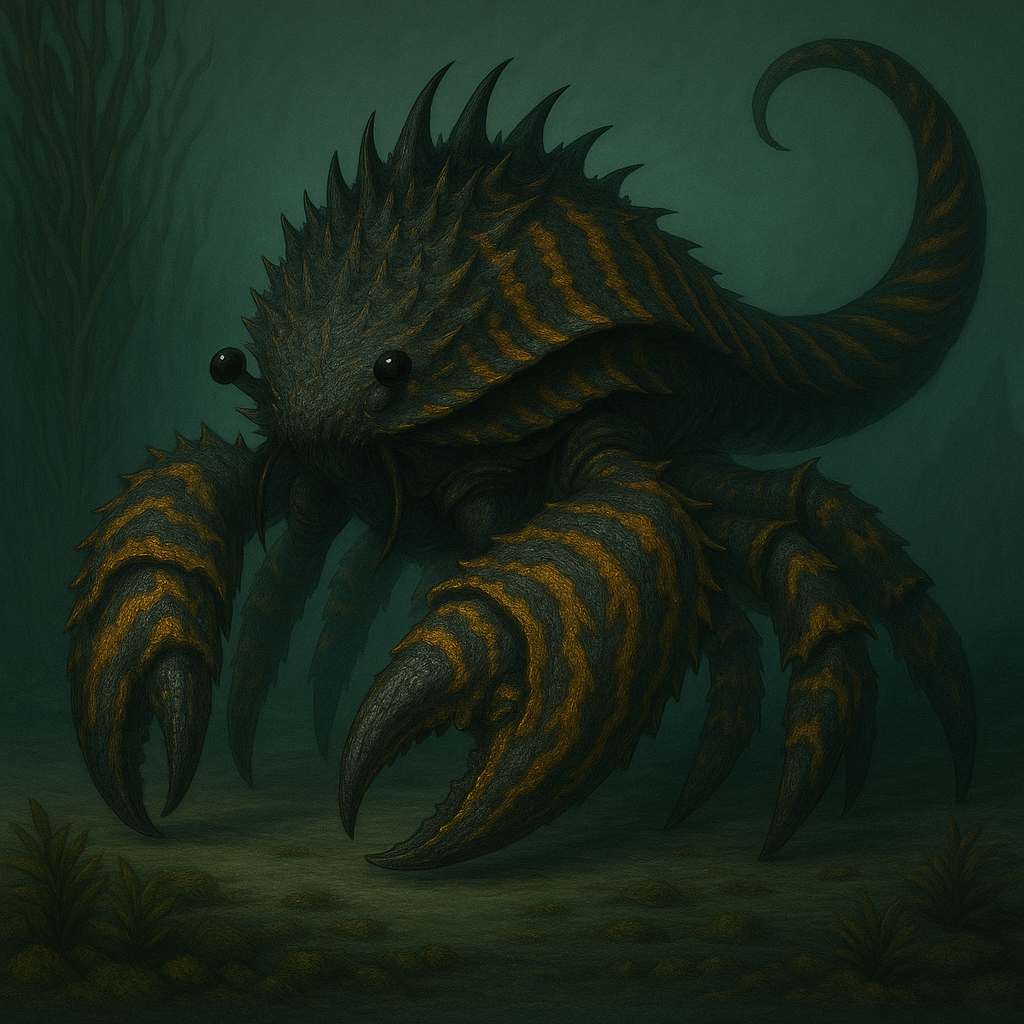Kelpstalkers
Where light ends, the Kelpstalker begins.
The Kelpstalker is among the most dreaded sea-creatures haunting the darkest reaches of Everwealth's waters. Resembling the unholy union of a crab and an eel, it is a master of ambush, subterfuge, and brute power. Massive, cunning, and clad in armor like forged midnight, it stalks the seabed with predatory patience, striking from clouds of ink that only it can see through. Most who witness it never live to describe it. Those who do speak of a shadow rising, kelp-colored and clicking, crowned in ruin. On rare occasions, the Kelpstalker has crawled ashore, and when it does, it does not retreat until the beach is cleared of movement or meat.Basic Information
Anatomy
The Kelpstalker possesses a rare, seamless dual-form anatomy. Its forward half is that of a jet-black crustacean, a towering, heavy-bodied crablike creature with two massive claws capable of crushing reefstone. Behind this armored body flows a muscular, eel-like tail stretching nearly two-thirds of the creature's length from the mouth to the end of the tail, giving it immense speed and mobility through water. The transition between crab-body and eel-tail is without seam, joined by dense layers of armored chitin and flexible muscle. Distinct orange striping decorates its otherwise abyssal gray-black hide, appearing green to most fish and lesser prey due to their limited color vision, a natural illusion that allows it to move unnoticed even in shallow coral forests. Each claw is nearly the size of a man, and its undershell features ridges capable of skimming over sand without sound. Its eel-tail contains a hardened whip-blade fin that can lash with enough force to shatter bone.
Genetics and Reproduction
The Kelpstalker is oviparous, with females laying dense, barnacle-like egg clusters on steep undersea cliffs. These are fiercely guarded until hatching. Only one or two young usually survive, as hatchlings often eat their weaker siblings. There are theories that Kelpstalkers possess latent adaptive magickal mutations, allowing some regional variance in their camouflage striping or ink cloud composition. These mutations may contribute to their long evolutionary survival.
Growth Rate & Stages
- Hatchling (0-3 months): 4 ft long, soft-shelled, vulnerable.
- Juvenile (3-24 months): Begins predatory swimming, develops defensive ink.
- Mature (2+ years): Fully grown, territorial, capable of hunting whales or ships.
- Average lifespan ranges from 25-40 years, depending on environmental stress and available prey.
Ecology and Habitats
The Kelpstalker resides primarily along ocean floors with deep crevices, ancient shipwrecks, or kelp-laced canyons. It uses its coloration to blend into the seabed, lying motionless for hours. It thrives in regions where magickal residue or organic wreckage accumulates, sometimes dragging drowned carcasses to dens for unknown purposes. While considered fully aquatic, several rare reports document them dragging themselves ashore during feeding frenzies, usually near overfished coastlines, flooded coves, or ritual sacrifice sites. When on land, it moves with unsettling grace, dragging its massive tail behind it and using its claws to vault forward.
Dietary Needs and Habits
Obligate carnivore. Feeds on:
- Glintspears (crimson marlin-like fish).
- Reefripper sharks.
- Large bait schools (such as Hooligans or Griefscales).
- Carrion, wreck-scrap, and shipbound crew.
Biological Cycle
The Kelpstalker grows rapidly during bloom seasons when bait schools are abundant. During cold tides, it slows metabolism and often buries itself in sand or kelp beds. Every five years, it molts its outer shell in a ritual-like frenzy, tearing away the barnacles and coral growths that adorn it. This process often leaves the creature highly aggressive.
Behaviour
Highly intelligent, with evidence of territorial marking (using corpse placement) and trap-laying. Has been observed herding smaller fish into coral choke-points or driving pods of prey into shallows for later feasting. Notoriously territorial, especially around its breeding cliffs or corpse dens. Seems drawn to magickal activity or bloodshed in coastal waters. Does not flee combat unless outmatched, and often attacks ships in retaliation if wounded.
Additional Information
Perception and Sensory Capabilities
- Night vision beyond natural norms.
- Pressure and vibration sensing via chin whiskers.
- Heat detection through tail fin ridge-line.
- Can detect metal concentrations and blood in minute amounts over long distances.
Scientific Name
Charybdocancer profundis.
Origin/Ancestry
Believed to be a Pre-Schism apex predator originating from the Hadalgroves,an ancient trench system beneath the eastern Laughing Sea. Some posit it is the descendant of an alchemically-altered siege creature or war-beast, bred by drowned empires .
Conservation Status
Actively avoided. Hunted only by fools or famine.
Geographic Distribution



Comments